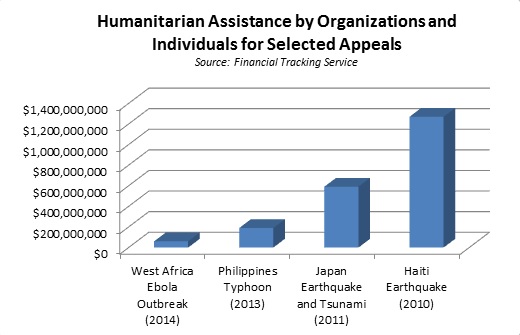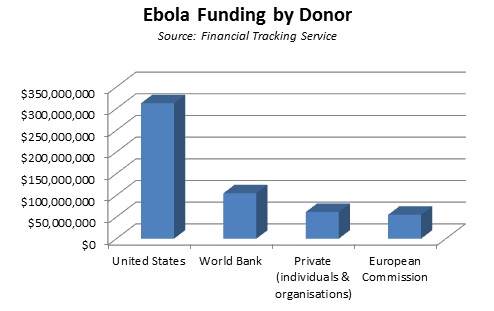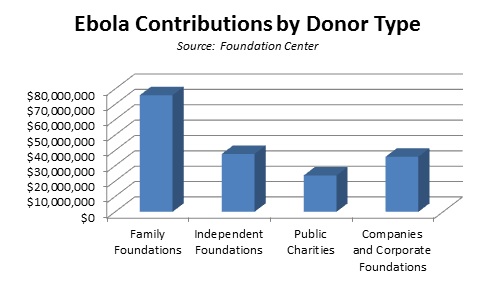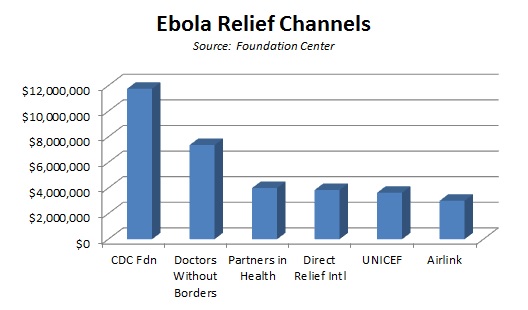Andrew Grabois of the Foundation Center examines the fundraising data behind the fight against Ebola.
An analysis of figures compiled by the United Nations Office for the Coordination of Human Affairs (OCHA) Financial Tracking Service shows that the global response to OCHA’s billion dollar appeal for the Ebola outbreak in West Africa has been an outlier. For example, looking at just funding (not including uncommitted pledges) from private individuals and organizations, we see that the current appeal for assistance in West Africa has yielded a fraction of what was raised for the Haitian and Japanese earthquakes and the typhoon that devastated the Philippines:

While it is true that the totals for other humanitarian appeals reflect campaigns that have lasted for years, with some still ongoing, it is hard to imagine that the Ebola appeal will make up the difference or meet its funding requirements – at least not from private individuals and organizations. Doctors without Borders, Partners in Health, International Medical Corps, and Direct Relief International all told the New York Times that fundraising has yielded nowhere near what they’ve received from previous appeals or what is needed to adequately respond to the current crisis. The American Red Cross, who raised almost $500 million for Haiti and more than $85 million for the Philippines, has so far received less than $3 million for Ebola – $2.8 million of which came from the Paul G. Allen Family Foundation.
In addition to the United States, United Kingdom, Canada, and the European Commission (the executive body of the European Union) who continue to be major contributors to UN appeals for humanitarian assistance, the Ebola crisis has inspired normally staid financial institutions like the African Development Bank and the World Bank to become activist donors. Mandated with providing low interest loans to developing countries for capital programs that promote foreign investment and international trade, the World Bank in particular has charged headlong into the Ebola crisis. Led by World Bank President Dr. Jim Yong Kim, a trained medical doctor and anthropologist and former president of Dartmouth College, the Bank has pledged $218 million in grants (not loans) to combat the disease, with its first installment of $105 million reaching the governments of Liberia, Sierra Leone, and Guinea in just nine days. The World Bank’s contribution is more than 12% of total contributions, second only to that of the U.S., who together account for 49% of all confirmed contributions and commitments:

Foundation Center tracks the response of charitable organizations and companies to humanitarian crises and it has compiled its own detailed figures for that universe of donors. Because Foundation Center does not distinguish between a pledge and a confirmed contribution, and works with a donor universe that does not include national governments, nongovernmental organizations, and private individuals, their figures will be different than those compiled by the United Nations. That being said, Foundation Center has identified 117 grants and gifts from foundations, charities, and companies worth more than $173 million. This is more than the total contribution from these donors to the Philippines after Typhoon Haiyan, but significantly less than donations for the Haitian and Japanese earthquake relief efforts. What is interesting and unusual about the response to Ebola as captured by Foundation Center is the disposition of the donors, with corporate contributions making up 79% of the grants but only 21% of the total dollar value of contributions. In this appeal, family foundations (i.e. Bill Gates and Paul Allen) accounted for the lion’s share of contributions:

Not only have the donors changed, but so have the recipients. Foundation Center has found that the Ebola relief landscape is populated with an entirely new array of channels for funneling institutional contributions. At the forefront and on the front lines now are organizations unfamiliar to many if not most Americans, like Doctors Without Borders, Partners In Health, and Direct Relief International – the very same ones that were profiled in the New York Times because they were having so much trouble soliciting contributions from individuals. According to Foundation Center these relief organizations – and a few others like Samaritans Purse and International Medical Corps – account for 78% of all grants with a specified recipient:

Why has the Ebola appeal had so much trouble gaining traction with individuals in the U.S. and elsewhere? Pundits point to the hopelessness of a frighteningly high mortality rate, the absence of emotionally potent and encapsulating images, and a general unfamiliarity with West Africa. Perhaps, but just as likely, this reticence reflects an assessment by ordinary citizens that the scope and possible consequences of the Ebola epidemic are just too overwhelming for non-state solutions – especially when those solutions involve building a health care infrastructure on the fly in three countries, populated by 20,000 doctors and other medical professionals that have to be recruited, trained, transported and, if necessary, evacuated, something only national governments and international organizations acting in concert have the resources to do.
Foundation Center has made all information on Ebola-related grants from charitable organizations and companies available in an RSS feed, including details on grants, grantmakers, and recipients. Working together with its partners – the Center for Disaster Philanthropy, the U.S. Chamber of Commerce Foundation Corporate Citizenship Center, the Council on Foundations, and the United Nations Office for the Coordination of Humanitarian Affairs (OCHA) – Foundation Center will continue to track the global response to the Ebola crisis and report its findings.
Many thanks to Andrew Grabois and the Foundation Center’s GrantCraft for allowing us to cross post such an insightful article on Markets For Good.
To stay up to date with the latest Markets For Good articles and news, sign up to our newsletter here. Make sure that you are also following us on Twitter.
